L’Association canadienne des physiciens et physiciennes a lancé son premier concours, l’Art de la physique, lors de leur congrès annuel de 1992, à Windsor, Ontario. Ce concours cherche à intéresser les gens, spécialement les profanes, à la fascinante imagerie de la physique.
À partir d’avril 2023, ce concours est suspendu jusqu’à nouvel ordre.
2019 gagnants

Rainbow in a Jar
This photograph displays a jar of water under the sun. The container was first filled with cold tap water as it allows more gas to dissolve. The container is then left at room temperature for a day, allowing the water to warm up and release gas, creating what we see as bubbles. Sunlight is a mixture of light with different wavelengths, and as light travels through various mediums of different refractive indices, the rays bend. The angle of bending varies for different wavelengths of light creating the rainbow colours. The sun rays first refracted into the glass, then into the water, the air in the bubbles, back into the water, the glass, out into the air, and lastly to the camera. This image captures a complex case of refraction and showcases the beauty of natural light.
Gracie Zhang
Victoria Park Collegiate Institute
Toronto, ON
2019 Art of Physics Competition
High School/CEGEP Individual Category, First Place

Firebending Cool Flames
This photo shows blue flames caused by flammable hand sanitizer. There are fingers that are on fire in the corner caused by holding the flammable hand sanitizer. The hand sanitizer is 70% ethyl alcohol, a flammable substance that allows the hand sanitizer to be set on fire. However, the water in the hand sanitizer douses the flames quickly, keeping the temperature if the flame low enough to be touched.
The water in the hand sanitizer has a high specific heat capacity, meaning that a higher amount of energy, in this case thermal energy, is needed to increase the temperature of the water. Therefore, although the hand sanitizer is on fire and is releasing thermal energy, the water absorbs a lot of it and with the water’s high specific heat capacity, keeps the temperature of the flame low enough to touch bare handed for a second.
Maggie Yang
Victoria Park Collegiate Institute
Toronto, ON
2019 Art of Physics Competition
High School/CEGEP Individual Category, Second Place
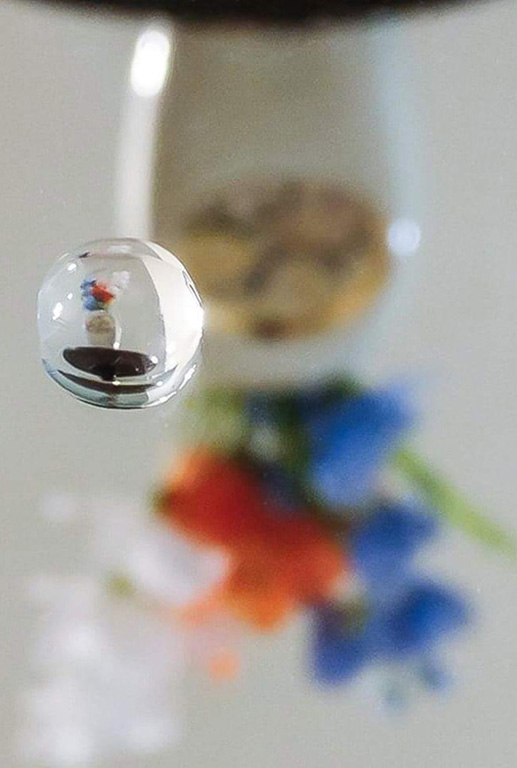
The Reflected Vase
The above photo demonstrates reflection, refraction, and properties of light. The image is a droplet of water reflected on a flat mirror, illustrating the reflection of a vase of flowers and its image produced in a droplet.
The image produced by the mirror is inverted as the light that comes from the vase hits the mirror at an angle, causing the light from the vase to switch order and appear inverted. In convex lenses, incoming light is converged and focused at the focal length, the distance from a lens to its focus. As light travels between two mediums of different thickness and density, it bends because light travels faster through thinner mediums, a phenomenon known as refraction. Objects at a distance greater than the lens’ focal length produce inverted images. The droplet acts as a convex lens and the vase is a distance farther from its focal length, inverting the reversed image of the vase, and producing the upright image in the droplet. In this photo, the image produced from the reflection of the vase is compared effectively side by side with the image from the inversion of this image through a water droplet.
Bahir Ali Latif
Victoria Park Collegiate Institute
Toronto, ON
2019 Art of Physics Competition
High School/CEGEP Individual Category, Third Place

Refracted Light
This image was taken by shining a light through a plastic apple, which appears distorted behind a sheet of clear, textured resin. To create this texture, liquid resin was left to harden in a sheet of crumpled wax paper. The photograph demonstrates the refractive property of light. As light passes from one substance to another, the difference in density between the two mediums case the speed and wavelength of the lightwave to change. When light enters the second medium at an angle, the part of the wave that reaches the medium first is slowed down, causing the ray to bend and alter the direction of its path. In the photograph, the resin’s texture causes light from the plastic ball to enter it at several different angles. Light which normally travels away from the viewers is refracted by the resin, causing it to bend towards the viewer’s eye. This refraction creates the distorted appearance of the illuminated apple.
Maggie Wang
Cawthra Park Secondary School
Mississauga, ON
2019 Art of Physics Competition
High School/CEGEP Individual Category, Honorable Mention
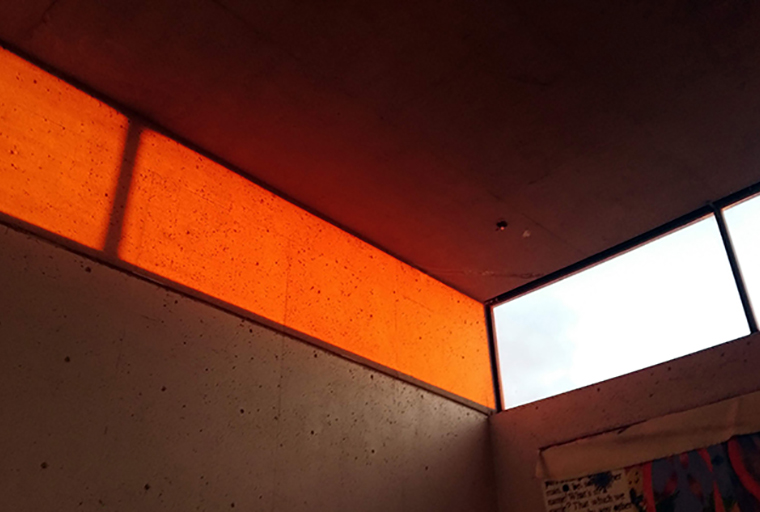
Golden Hour
This image was taken at school during sunrise, or what is commonly known as golden hour in photography. As the light waves from the sun travel through the atmosphere, the come into contact with particles and are scattered in all directions. Shorter blue and violet wavelengths are scattered more frequently due to their wavelengths being similar in size to air [particles, making the sky appear blue during the day. During sunrise and sunset, however, sunlight must travel a great distance through the atmosphere to reach our eyes. As a result, the blue and violet light waves are scattered so completely that most do not reach our eyes or the surface around us. The remaining light that reaches us is mainly composed of longer, red and orange wavelengths, illuminating the objects they hit with warm, golden hue. In the picture, the red and orange light of the sunrise cause the areas of the otherwise dull brown wall they land on to appear a brilliant orange.
Maggie Wang
Cawthra Park Secondary School
Mississauga, ON
2019 Art of Physics Competition
High School/CEGEP Individual Category, Honorable Mention
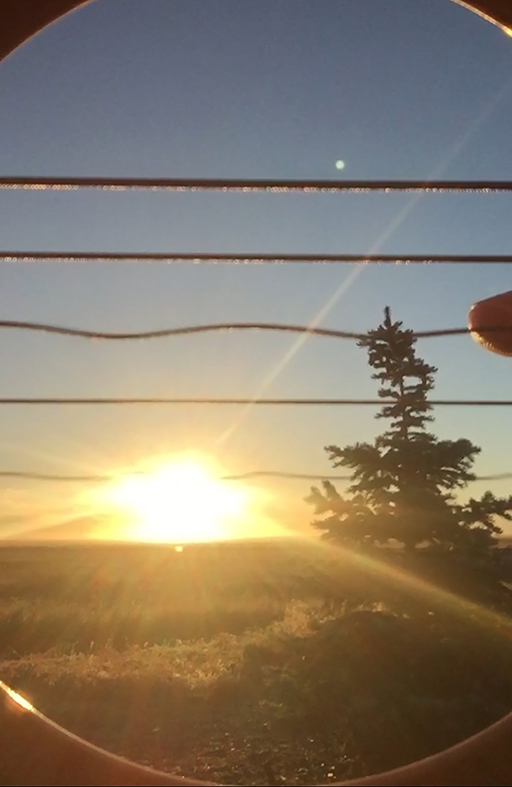
Here Comes the Waves
This is a photo of me playing a song on my guitar, taken with my cell phone from inside the guitar. The vibrating guitar strings produce sound waves. The air molecules that surrounds the strings, then, are set in a vibrational motion that matches the frequency of the vibrating strings. There is an alternating pattern present in the vibrations that create pressure waves. These waves are made of rarefactions and compressions. Rarefaction is the area with low pressure while compression is the area of high pressure due to more air molecules being compressed together. Consequently, this alternating pattern would result in sound waves, thus, creating a tune on the guitar. v = f is the formula used to define the relationship between wavelength and the frequency. The (v) stands for the speed of the wave, (f) as the frequency and lambda as the wavelength. The pitch of the strings can be explained with the following ideas. Speed, tension, and mass are all related in terms of the resulting sound wave. For example, the thinner and more tensioned strings at the bottom of the guitar would create a higher frequency as the waves would travel faster. In contrary, the top strings with greater diameter would exert lower frequencies as the waves would travel slower. That is why the strings of the guitar varies in thickness. The inside of the guitar, also known as its body, compliments the sound waves in terms of amplifying the volume. The air molecules that are gathered inside the body would match the frequency of the vibrating strings. Because of the body, it allows more air molecules to parallel the frequencies and, therefore, allowing the sound to become louder.
Cywin Tapia
Weyburn Comprehensive School
Weyburn, SK
2019 Art of Physics Competition
High School/CÉGEP Class Project Category, 1st Place

Goutte d’eau: lentille optique naturelle
Les lentilles optiques sont des objets qui ont pour but de faire converger ou diverger les rayons de lumière. Elles sont utilisées partout dans notre vie : les objectifs d’appareils photo, les lunettes correctrices, les loupes, etc.
Dans ma photo, la goutte d’eau suspendue à la feuille agit comme une lentille convergente, grâce à sa forme sphérique et à l’indice de réfraction de l’eau supérieur à celui de l’air. Puisque la distance de l’objet (la fleur) est supérieure au double de la longueur focale, lorsque les rayons traversent les surfaces de la goutte, ils vont converger du côté opposé à la fleur pour former une image renversée, plus petite, réelle, située entre la goutte et l’appareil photo.
Antony Hu
Cite-des-Jeunes
Vaudreuil-Dorion, QC
Concours L’Art de la Physique 2019
Catégorie Project de classe, 2eme Prix
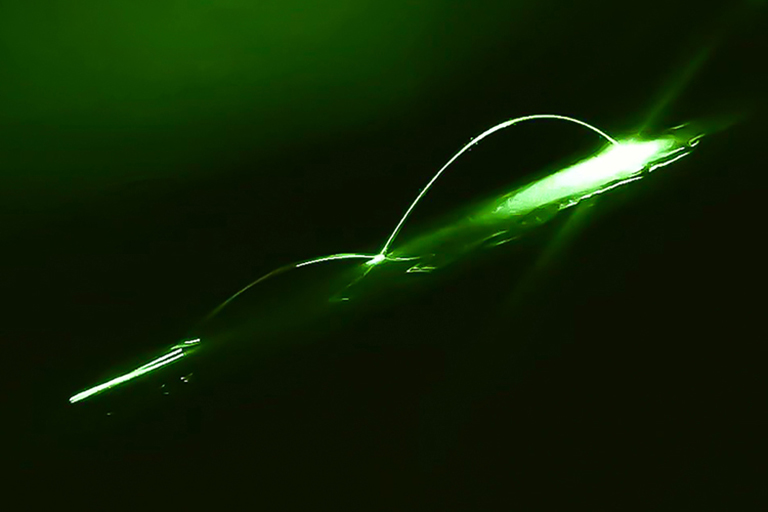
Bouncing Laser Jet
This image displays a thin stream of shampoo bouncing off an inclined surface with a laser pointer directed at the start of the stream. This occurs for just an instant in real life, which is why it is difficult to believe a common household product like shampoo can exhibit such strange properties.
This phenomenon is known as the Kaye Effect, first noticed by Arthur Kaye in 1963. As the shampoo piles up on the inclined surface, a dimple is formed where the stream hits the viscous pile. The shampoo experiences shear-thinning, meaning it’s viscosity (thickness) decreases under shear (sliding) force of the falling shampoo. This causes the dimple to deepen over time, acting as a ramp for the shampoo jet to rise and cascade down the slope.
Furthermore, the laser beam experiences total internal reflection inside the stream of shampoo, since the light strikes the inside of the stream at an angle greater than the critical angle of the substance. As a result, the light does not exit the stream and appears as though it is bent.
Akshay Ramasubramanian
Vicotria Park Collegiate Institute
Toronto, ON
2019 Art of Physics Competition
High School/CÉGEP Class Project Category, 3rd Place
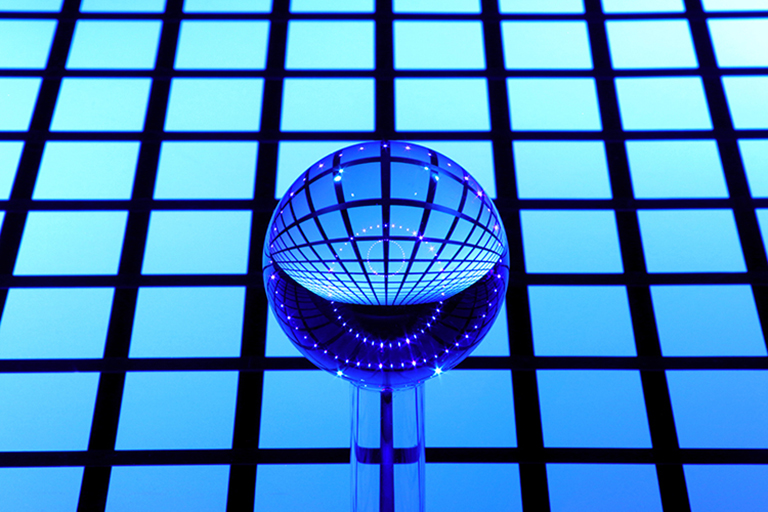
Coefficient de Fresnel
Souvent, quand on regarde dans une vitre, on ne voit pas uniquement la lumière transmise à travers le verre, mais aussi notre réflexion.
Quand une onde lumineuse traverse le dioptre d’un milieu transparent ayant un indice de réfraction différent du milieu d’origine, une fraction du rayonnement est transmise et subit une réfraction, alors que l’autre part est réfléchie. À partir des équations de Fresnel, on peut déterminer un coefficient qui décrira les fractions réfléchie et transmise d’un rayonnement incident. L’angle d’incidence affectera le coefficient de réflexion ainsi que la polarisation du rayonnement réfléchi. Aussi, une augmentation de la différence entre les indices de réfraction des milieux d’origine et de transmission accroîtra la fraction du rayonnement qui sera réfléchi.
Pour un rayon à incidence normale sur du verre d’indice n = 1,5, la fraction réfléchie sera de l’ordre de 4%; et de 8% si on considère la 2e surface.
Pour illustrer ce phénomène, une sphère de verre est placée sur un quadrillage puis est éclairée avec deux plafonniers et un cerceau supportant 45 diodes électroluminescentes bleues. On peut observer la réfraction renversée du quadrillage ainsi que les réflexions multiples des DEL.
Richard Germain
Pointe-des-Cascades, QC
Concours L’Art de la Physique 2019
Catégorie Ouvert à tous, 1e Prix
